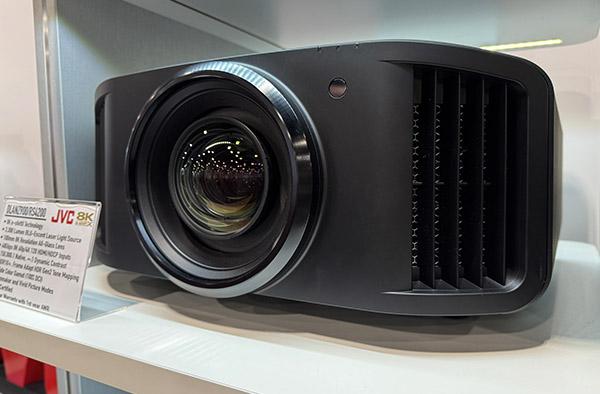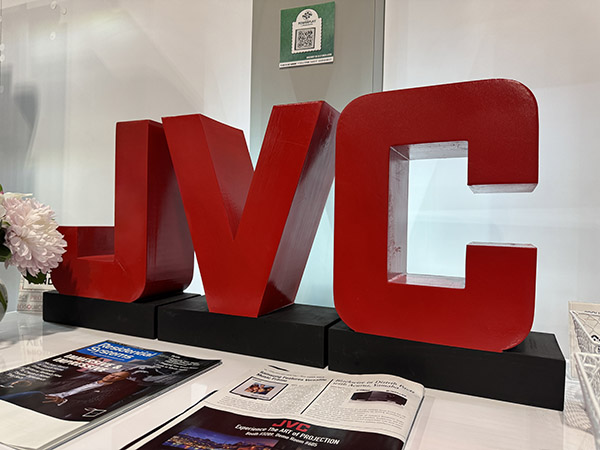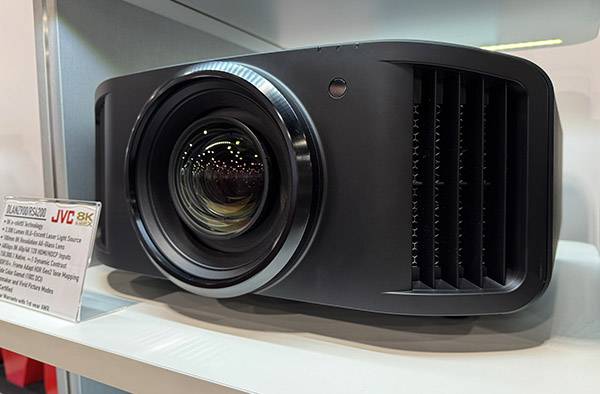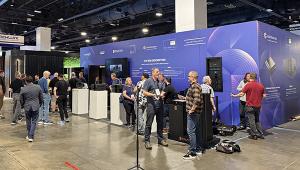JVC and Grimani Systems Demo at CEDIA 2024: A Dynamic Range Masterclass

Released a few months ago, this was the first opportunity to see it properly demoed, providing a true sense of what it can deliver in a well-designed (totally blacked-out) space. With a native contrast ratio of 150,000:1 and 3,300 lumens of laser-driven brightness, I thought this projector produced the most visually stunning projected image at the show. Audience gasps indicated others felt similarly.
The Contrast King
JVC is renowned for its black levels, and the DLA-NZ900/RS4200 takes that legacy even further. Powered by three Gen3 0.69-inch Native 4K D-ILA devices (one for each primary color), it delivers true 4K resolution and e-shift 8K (all pixels addressable) with incredible sharpness. Yet, it’s the native contrast that steals the show. It brings deep blacks that provide a foundations for dazzling highlights, making the image pop with brilliance.
The projector can achieve close to 300 nits on a 120-inch 1.0-gain screen, which allows for stunning HDR performance. However, this also underscores the challenge of scale. Of course, at a more conservative 100-nit peak brightness the DLA-NZ900/RS4200 can fill much larger screens while still delivering excellent HDR, thanks to its dynamic tone mapping capabilities.
The picture quality was so impressive, I couldn’t help but compare it to OLED TVs. The DLA-NZ900/RS4200 offered the same deep, inky blacks that OLED is famous for, but on a much larger scale. This is where JVC excels—bringing that OLED-like visual quality to a screen size TVs can't touch.

While 3,300 lumens is impressive for a high contrast home theater projector, JVC’s models have a brightness ceiling compared to some competitors. This level of brightness works beautifully in a dark, controlled environment but isn’t ideal for rooms with a lot of ambient light. For that, there are other options.
Bigger Than OLED, But Still OLED-Like
What truly impressed me was how JVC brought OLED-like quality to a size OLED TVs can’t reach. While other, pricier projectors at the show might have been brighter, none matched the visual impact of JVC in a dark space, even projectors costing a lot more.
If you need a projector that can cut through ambient light or scale to a massive screen, other options exist. But if you're building a home theater and want a truly cinematic experience, JVC remains the top choice. Ultimately, it’s not just about brightness—it’s about picture quality, and JVC nailed it.
Video Transcript:
Mark Henninger: Hey, what's up, Mark Henninger here at CEDIA 2024. Sound and Vision is visiting the JVC booth. I'm here with Patrick and he's going to take us to JVC's brand n ew projectors, which I witnessed in the demo. And I got to say, best looking picture I saw at the show. So how did you do it? And what is it?
Patrick Siebert: Mark, thank you so much. So this year, we're really excited this year for CEDIA. CEDIA 2024, we're able to introduce two new products. And the amazing thing is people have been asking us for a long time. How can we get into a DLA projector that's laser that's a little bit more affordable. So coming in November, we're going to have the new NZ500 or RS1200. That's our laser projector that's going to replace our lamp. So we're going to get you 40,000:1 native contrast ratio that you're already, that you're used to from JVC technologies. We're going to get you 2,000 lumens. 6,000 dollars... $5,999.95.
MH: Damn.
PS: We're super excited about that one. And then when you step up to the NZ700 or 700 slash RS2200 you're at 2,300 lumens. It's still a native 4K projector with an 80mm glass lens assembly. 80,000:1 native contrast ratio. It does a 98% DCI/P3 color gamut. The laser projector. And the nice thing about this one is we're taking that NZ8 technology, that RS21 technology that you're used to, and we're going to give you double the contrast, 80,000:1 contrast as opposed to the 40,000:1 that you would have expected from the last year's model.
So as we step over here, now these products were released in May. So these aren't a big surprise, but a lot of people haven't gotten to see them yet. So, this is one of the ones that we have on display. Hopefully this is the one they're talking about. This is the big dog. This is the NZ 900 or RS 4200 8K projector. That's right. It's a native 4K chipset, but it'll do 8K e-shift now and every pixel is addressable in that unlike standard e-shift, which is about half the pixels. But it'll take 8K 60p in. But the amazing thing is with our new scaling engine that feeds the 8K, you can take in 1080 and it'll scale it up to 4K. It'll scale it up to 30 to 8K to 35.5 million pixels. So we have an incredible processor. You get incredible 8K e-shift with this projector. It’s got a 100-millimeter all glass lens assembly, a hundred percent DCI-P3. And we raised the contrast ratio from a hundred thousand one to a hundred and fifty thousand.
MH: Can I admit something? I did not even think about that 4K/60 upscale to 8K, that's why you want to have 8K/60 capability.
PS: Well it's not even that imagine watching your favorite football game six feet away on a 130-inch screen, 150-inch screen, a 160-inch screen, 200-inch screen and now you're getting 35.5 million pixels that are addressable intelligently designed pixels from 1080 all the way up to 8K. It's fantastic. I'm super… That’s my favorite thing about this projector is that new scaling engine, now we're still giving you dynamic tone mapping and that's on all of the DILA projectors that we were talking about.
We give you a dynamic tone mapping built in. Three-year warranty, 100% DCI-P3 color gamut, this is our flagship, we're really, really proud of this one. We've got a bunch of other features built into it, we've got Filmmaker mode, we've got Theater Optimizer, but this is the flagship, and this is one of the projectors you got to see inside.

MH: That's 150,000:1 contrast, right? 150,000:1 native.
PS: Native.
MH: Yeah, that number kind of blew my mind, but then it was right there on screen and I was like, ah, there it is.
PS: Well, to be perfectly honest with you, if you noticed last year we had an anniversary model. So we were testing new technologies out on our LCoS chip. So with that anniversary model, we launched that technology, the LCoS chip, getting 150,000 native contrast. That worked out so well, everything's been working perfectly in the field, so we're introducing that to you this year in that new product.
This new product is also going to be in the NC800 or RS3200. This is also going to give you the 8K shift. It's also going to give you 2,700 lumens. A little bit down from the 3,300 lumens you're getting with the big dog, but that's partially because of the size of the lens. We're doing a 65 millimeter lens on this one, so it's not quite as efficient. And the great thing about this one is now you're doing 100,000:1. So all those people that enjoyed the 100,000:1 native contrast on the NZ8 or NZ9 or the NX9, now you're getting 100,000:1 on a much lower price point at $16,000.
This projector also is going to do that 8K e-shift for you. This projector is also going to give you 100% DCI-P3 color gamut and 8K 60P input, 4K/120 for the gamers, and all these lasers are going to give you about 20,000 hours of working life.
MH: I love gaming on a projector. I've got to say that. It's incredible.
PS: And now that you have, not just us, but now that you have everyone out there on the market that's doing laser technology that has 20,000 hours, you don't feel guilty of kind of rocking out for 8 or 9 or 10 hours on a video game and go, I just spent so much of my lamp's life. And that is all over.
And the last bit of our projector is our DLP projector. This is an affordable model from JVC for $3,500. It's a DLP projector that does 4K DLP technology, so it does have some pixel shifting involved. It's 100% of Rec. 709 color space.
MH: So what you're getting also is JVC picture processing.
PS: You're getting an advantage. It's not D-ILA technology, so you don't get to have all that amazing power, but you do have a little bit better picture processing. You have lens shift. And one more thing I wanted to mention is even on those entry-level projectors, we have electronic motorized lens shift, so it's not mechanical. And that's on everything in the D-ILA lineup.
MH: Very nice. Thank you. Appreciate that, Patrick.
PS: Thank you so much, Mark. I really appreciate you coming in.
MH: Here at CEDIA 2024 with Anthony Grimani.
Anthony Grimani: Hey Mark, how are you, man? We're here at CEDIA 2024, and we're doing a demo in partnership with JVC. They're showing two of their really stellar little projectors. And what we brought out here is, I would say, our entry-level sound system, which is called Cinema 5. Last year, we had a big demo room. We had the big cannons called Cinema 1—big, just big. And this year, we're showing the opposite side of the spectrum, which is a system that would fit well in a room that's 18 or 20 feet long. So that's what's in there.
It's coupled with a 140-inch wide screen, and people can see just basically how dynamic even our smallest speakers are in a room like this. So what we have for speakers in there is interesting. We have a pair of left and right kind of bookshelf speakers about this big sitting on a stand. In the center, we have a horizontal center speaker. We call it a horizontal bar. It's not multi-channel, it's just carrying the center channel in the case of this room.
We have a pair of side speakers. It's actually a reformed version of that same bookshelf speaker, but in a really shallow form factor. We have two ceiling speakers for the top channels in Atmos that are these wedge-shaped speakers that push the sound down towards the listening area. And finally, we have four subwoofers with 12-inch drivers in the four corners of the room, and optimized for the bass of the room. Ultimately, it sounds amazing. It couples well with the price point of the projector and the entire system in there."
MH: Clearly, I gotta get my ass in there and check it out.
AG: Get your ass in there right now.











































